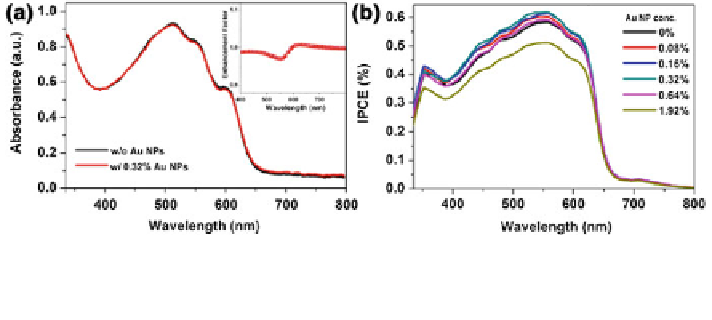Environmental Engineering Reference
In-Depth Information
Fig. 8.4 a Absorbance of PEDOT:PSS/P3HT:PCBM film with or without Au NPs incorporation
(0.32 wt%); inset of (a): theoretical absorption enhancement factor (detailed model shown in
Appendix A
); b IPCE of the solar cells with various Au NP concentrations in PEDOT:PSS [
18
]
LSPR is at about 580 nm, although the enhancement is weak. The theoretical
results and reflectance measurements also show that the Al electrode does not
obviously affect the LSPR effect on the absorption enhancement as the Al elec-
trode is situated far (220 nm) from the PEDOT:PSS layer.
The reason for the small optical enhancement is that when light is incident in
normal into the device through ITO, the very strong near field around Au NPs due
to LSPR mainly distributes laterally along the PEDOT:PSS layer rather than
vertically into the adjacent active layer as shown in Fig.
8.5
. As a result, no clear
light absorption enhancement can be obtained in the active layer of P3HT:PCBM.
Importantly, the understanding can also be applied to other cases with the metallic
NPs (such as Ag, Pt etc.) incorporated into the buffer layer adjacent to the active
layer of typical organic thin-film solar cells due to the lateral distribution feature of
the strong near-field. Meanwhile, the work suggests that near-field physics needs
to be accounted for in the optical design of photovoltaics, and some traditional
physical quantities, such as scattering cross-section, are not enough to fully
characterize the optical properties of OSCs. For instance, typically, scattering
cross-section is very useful to locate the plasmonic resonance region and deter-
mine the strength of scattering [
21
,
22
]. However, it cannot provide the directional
properties of electric field, and thus the direction dependence of absorption
enhancement.
Although there is no obvious enhancement in the light absorption of the active
layer, IPCE of our PEDOT:PSS:Au NPs devices increases with Au NP concen-
tration and the 0.32 wt% device shows the highest IPCE, with *64 % at 550 nm
as shown in Fig.
8.4
b. For higher Au NP concentrations, IPCE decreases. This is in
good agreement with the trend of J
sc
. The apparent discrepancy between light
absorption and IPCE can be explained by the fact that IPCE measures the per-
centage of incident photons that eventually results in free charges being collected
through the OSC electrodes. Factors beyond light absorption, such as the resis-
tance of electrodes, exciton dissociation rate, and charge collection efficiencies
will also affect the magnitude of IPCE. However, such nonoptical effects are likely
to be not wavelength sensitive and are represented by vertical shifts of the entire

Search WWH ::

Custom Search